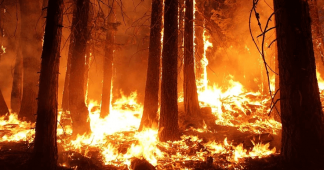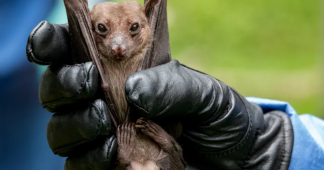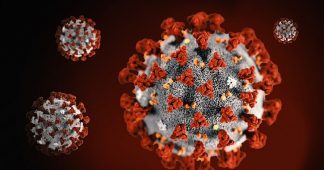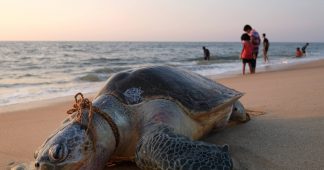“Human Miasma” by Priti Gulati Cox: embroidery and graphite on khadi fabric.
Humanity’s transgression of ecological limits has caused widespread damage, including a climate emergency, catastrophic loss of biodiversity, and extensive degradation of soils around the world. Earth abuse is also at the root of the Covid-19 pandemic and the grim likelihood that new pathogens will continue to emerge from other animal species to infect humans.
Cultivation, deforestation, mining, livestock raising, and other activities degrade and destroy wildlife habitat, leaving animals no choice but to move closer to humans, potentially bringing pathogens along with them. Suburban sprawl and tourism (especially “eco-tourism”) also bring humans and wildlife closer together. Hunting involves the most intimate contact with wild animals; indeed, the prevailing hypothesis is that the hunting of horseshoe bats probably kicked off the chain of events that led to the current coronavirus pandemic.
Humans have lived with domestic animals for millennia, and our bodies may have learned how to deal with the pathogens passed back and forth. But when ecosystems are disturbed or encroached upon, novel zoonotic viruses can move from wildlife into domestic animals and from there into humans. There is strong circumstantial evidence that the 1918-19 influenza pandemic, which killed more than 675,000 Americans and as many as 50 million worldwide, began with the flu virus jumping from swine into humans in Haskell County, Kansas, moving on to what is now Fort Riley with new army recruits, and from there reaching the battlefields of World War 1.
The horrific wildfires that were ignited across Southeast Asia for land-clearing in 1997-98, combined with a regional drought, killed off many fruit-bearing trees in the forests of Malaysia. Fleeing the dead forests, fruit bats found sustenance in domestic orchards, bringing with them the Nipah virus. Swine being raised within the orchards became infected through the bats’ virus-laden droppings and passed the virus on to the people who handled them. Nipah brings high mortality among both hogs and human population, killing approximately 50 percent of the people it infects.
We saw during the past year that once the new coronavirus gained a foothold in our species, the modern human propensity for long-distance travel quickly turned local outbreaks into a pandemic. Air conditioning, another technology with severe climate effects, was also implicated in Covid-19 outbreaks. Summertime, a season in which respiratory viruses typically wane, instead saw dramatic infection peaks throughout the Sun Belt as people escaped the heat and gathered in tightly enclosed, air-conditioned spaces.
Vacation cruises, which should have been banned decades ago given their exploitation of workers and heavy effect on the oceans and atmosphere, hosted some of the worst early outbreaks. The industrial meat industry, despoiler of soils and water, prolific emitter of greenhouse gases, also turned out to be an efficient viral incubator.
In some cases, greenhouse warming itself creates conditions for spread of zoonotic infection. In East and North Africa, for example, droughts have become more frequent and intense thanks to climate change. Many pastoralists have responded by replacing their cattle herds with camels, which, famously, can survive for long stretches of time without access to water. As a result, much larger numbers of camels are now in close contact with humans in the region. Worryingly, the coronavirus that causes Middle East respiratory syndrome is circulating in dromedary camel populations in several countries in the region.
MERS originated in bats, has become endemic in camels, and then over the past decade has repeatedly made the jump from camels into humans. It does not spread as readily from person to person as the Covid-19 virus, but it is orders of magnitude more deadly. Of approximately 2,500 people who have been infected by the MERS virus since 2012, one-third have died. As droughts worsen, farmers and herders take their camels on increasingly long journeys in search of forage. Trips often extend for days, and, without fuel for fire building, the herders often must sleep close to the camels for warmth. For want of fire and water, they also may sustain themselves by drinking the camels’ milk raw. All of this increases the risk of virus transmission.
We may wriggle out from under the Covid-19 pandemic by year’s end, but we won’t be in the clear. It is likely that we will continue to encounter novel coronaviruses. Never before the year 2000 were coronaviruses known to emerge from bats into human populations and cause highly lethal disease in humans. In the two decades since, however, there have been three such events, involving SARS-CoV-1, which caused the 2002-2004 “severe acute respiratory syndrome” (SARS) pandemic; MERS-CoV, which causes MERS; and SARS-CoV-2, the cause of Covid-19.
In a 2020 article in the journal Cell, David Morens and Anthony Fauci – yes, that Dr. Fauci – wrote that as we continue disrupting the ecosphere, pathogens are finding their way into human populations with increasing frequency: “The COVID-19 pandemic is yet another reminder, added to the rapidly growing archive of historical reminders, that in a human-dominated world, in which our human activities represent aggressive, damaging, and unbalanced interactions with nature, we will increasingly provoke new disease emergences. We remain at risk for the foreseeable future. COVID-19 is among the most vivid wake-up calls in over a century. It should force us to begin to think in earnest and collectively about living in more thoughtful and creative harmony with nature, even as we plan for nature’s inevitable, and always unexpected, surprises.”
Our encroachment on the ecosphere has opened a Pandora’s box. In addition to the viruses causing SARS, MERS, and Covid-19, some of the other bat coronaviruses studied so far have all the necessary pathogenic tools for attacking humans, and they have been shown to infect and sicken laboratory mice. According to a paper authored by a national group of ten researchers in the field, there are “enormous groups of bat coronaviruses distributed globally,” and many, like SARS-CoV-2, are “functionally preadapted” to infecting humans. That preadaptation may be related to similarities among bats, minks, cats, humans, and some other mammalian species in our lung-cell membranes’ susceptibility to entry by this group of viruses.
There’s more. Since 2017, another coronavirus – emerging, like the Covid-19 and SARS viruses, from horseshoe bats – has been triggering deadly outbreaks among piglets in China. In the laboratory, the new bug appears to have the genetic potential to infect human airway and intestinal cells. Three different coronaviruses that cause severe disease in cattle, horses, and swine are closely related to another virus that has long been causing the common cold in humans. These livestock viruses may acquire, through genetic exchange, the ability to infect us.
Scientists are becoming increasingly concerned about the propensity of different coronavirus strains to engage in recombination, that is, to swap blocks of genetic code with one another. Reportedly, the code for shaping the “spike” protein that allows the virus to enter host cells is especially prone to recombination, raising concerns that code for versions of the spike that can serve as “keys” for opening human cells to infection could pass from human pathogens like the Covid-19 or common-cold viruses into livestock viruses. The latter might thereby acquire the ability to infect the people who work around them. In researchers’ words, “[C]oronaviruses can change rapidly, drastically, and unpredictably via recombination with both known and unknown lineages.”
The ten scientists who warned that coronaviruses are functionally preadapted to the human body further stressed that their data “reaffirm what has long been obvious: that future coronavirus transmissions into humans are not only possible, but likely. Scientists knew this years ago and raised appropriate alarm. Our prolonged deafness now exacts a tragic price.”
What’s good for the ecosphere is good for human health, and we are not helpless victims. Escaping ecological catastrophe and reducing the frequency of pandemics that might be lurking in the decades ahead is well within our capability, but it will require assiduous respect for ecological limits and great restraint in our interactions with nature.
This article was originally published by The Land Institute’s Land Report.
Published at www.counterpunch.org











